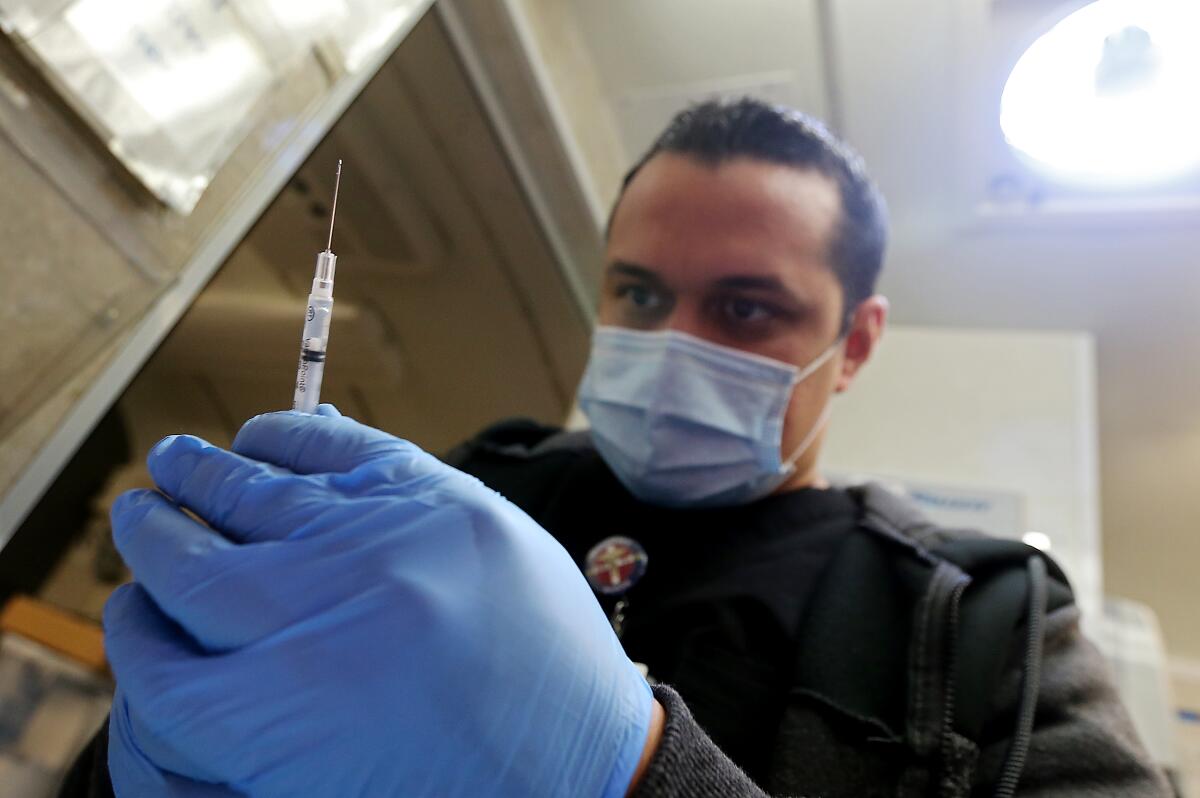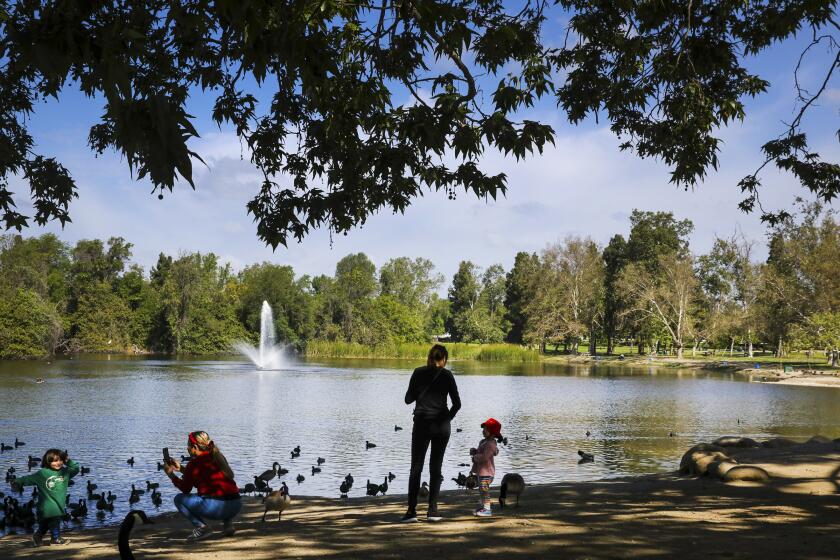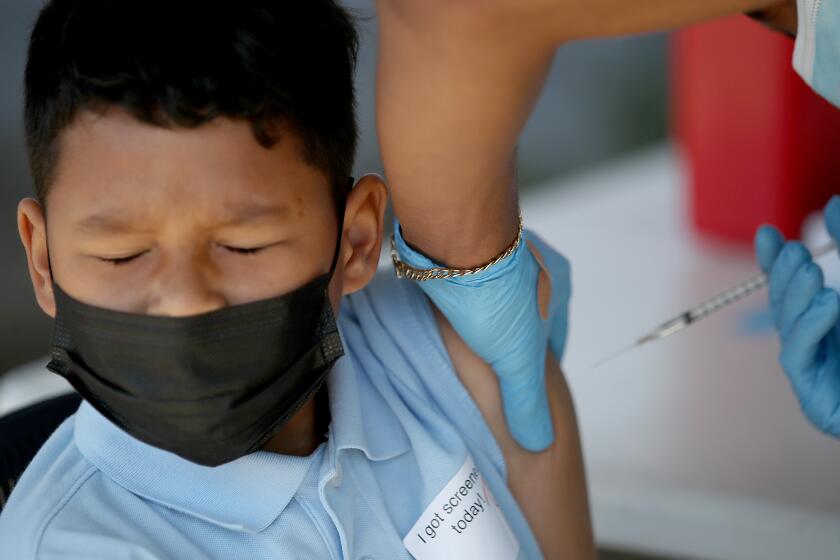The Omicron subvariant BA.2 is on the rise. We need to take it seriously, experts say

- Share via
There are increasing signs that the Omicron subvariant BA.2 is on the rise, even as the daily reported number of coronavirus cases continues to fall across California.
The jury is still out as to whether BA.2 — which is 30% to 60% more contagious than the original Omicron variant that raced through California over the winter — may spark another spike. But given how the latest strain has upended trendlines in other parts of the globe, many public health officials are urging caution.
Here’s what you need to know:
With infections rising in parts of Africa, Asia and Europe, officials say they wouldn’t be surprised if new cases climbed again in the U.S.
The big picture
The World Health Organization this week reported coronavirus cases were rising globally again.
“After a consistent decrease since the end of January 2022, the number of new weekly cases rose for a second consecutive week, with a 7% increase reported” from March 14-20 compared with the previous week, the WHO said in a report issued Tuesday.
And across the United States, health officials also are seeing an increase in the share of new coronavirus cases linked to BA.2.
Nationally, BA.2 comprised an estimated 35% of analyzed samples between March 13 and March 19. The previous week, it made up 22%, according to data published Tuesday by the U.S. Centers for Disease Control and Prevention.
In the Southwestern U.S. — which includes California, Arizona, Nevada and Hawaii — BA.2 made up an estimated 41% of coronavirus samples. The previous week, it was 28%.
The World Health Organization says new coronavirus cases globally increased by 7% in the last week, driven by the Western Pacific.
And for the first time, BA.2 is now believed to be the dominant subvariant in the Northeast, comprising more than half the analyzed coronavirus cases in New York, New Jersey and New England.
There are hints that weekly coronavirus cases have stopped falling in New York. For the week that ended Monday, the state was recording 82 cases a week for every 100,000 residents, up from a rate of 58 the prior week, according to Johns Hopkins University.
California perspective
For now, weekly coronavirus cases remain flat nationally and in California, and they are still declining in Los Angeles County.
California has been logging 3,000 to 4,000 cases a day, or roughly 60 to 70 cases a week for every 100,000 residents.
L.A. County has also reported its overall weekly coronavirus cases continue to decline, at least when subtracting a backlog of cases from earlier during the Omicron surge.
By Tuesday afternoon, L.A. County reached health officials’ long-awaited goal: fewer than 730 cases a day over the last week, or roughly 50 cases a week for every 100,000 residents, according to a Times analysis of county data. The number indicates a moderate level of transmission. Reaching that goal comes exactly in the range forecast by L.A. County Public Health Director Barbara Ferrer, who said in February she suspected the county would hit the goalpost of fewer than 730 cases a day by mid- to late March.
From Feb. 27 to March 5 — the most recent span for which data are available — 14.7% of coronavirus cases sequenced in L.A. County were found to be BA.2, up from 6.4% the prior week, according to figures from the county. However, officials note only a fraction of all cases are sequenced.
The increasing prevalence of BA.2 in many regions, Ferrer said, “reminds us that we need to remain vigilant and prepared for the possibility of more cases in the near future.”
“While discouraging to face this possibility, the best way to blunt another surge in cases from increasing hospitalizations and deaths is to increase vaccination and booster coverage,” she said in a statement. “Given the compelling evidence that the vaccines continue to protect against all variants, and their wide availability, residents and workers are urged to use the next couple of weeks to get up to date on their vaccines. Waiting until we start seeing increases in cases is not optimal.”
What should Californians be doing now to prepare for a possible spring surge of infections by the Omicron BA.2 subvariant.
Orange County’s coronavirus case rates are particularly low at the moment. According to data released Tuesday by Dr. Regina Chinsio-Kwong, the county’s health officer, Orange County is reporting about 26 cases a week for every 100,000 residents. It also is reporting a high vaccination rate for seniors, with more than 95% having received at least one dose.
A spring surge?
Dr. Robert Kim-Farley, an epidemiologist and infectious-diseases expert at the UCLA Fielding School of Public Health, said he expects to see either coronavirus cases flatten or a modest increase in cases, but nothing close to the most recent Omicron surge.
Kim-Farley said he suspected that California won’t be hit hard by BA.2 because so many people have a reasonable degree of immunity, either through vaccinations or having survived an infection of the subvariants that were dominant earlier (BA.1 or its descendant, BA.1.1). All that “will blunt the effect of the increasing percentage of BA.2,” he said.
Kim-Farley said he also expected weekly COVID-19 hospitalizations and deaths to continue falling, as more anti-COVID drugs become more plentiful, such as Paxlovid.
The City Council voted 13-1 to make it voluntary for businesses to verify that patrons are vaccinated. But because the vote was not unanimous, the proposed ordinance will undergo a second, procedural vote next week.
But he said he would be more concerned about a new variant that was even more transmissible and able to overcome the immunity provided by either vaccination or prior infection.
“That is always the wild card that could potentially lead to a significant problem,” Kim-Farley said.
It’s still important, he added, for people who have had prior COVID-19 infections to get vaccinated and boosted because the strength and duration of natural immunity appears to be less than through vaccinations.
How to prepare
Experts say it’s prudent to be prepared for a possible increase in coronavirus transmission by getting current vaccinations and boosters; adhering to California health officials’ strong recommendation to continue wearing masks in indoor public settings; and getting tested before and after gatherings.
Chinsio-Kwong urged residents not to get too complacent about official reports of low case numbers, noting that many people are now testing with at-home kits, and those results are not shared with the government.
“Even though we may not have a mask mandate in our county, it is still very important for everyone to continue to use precaution,” said Chinsio-Kwong. Health officials across California are still strongly recommending universal wearing of masks in indoor public settings.
For now, weekly coronavirus cases remain flat nationally and in California, and are still declining in Los Angeles County. But the data could be a prelude to what’s to come.
That also includes getting a booster shot if you’re eligible, Chinsio-Kwong added. Recipients of the Pfizer-BioNTech shot age 12 and older, and all recipients of the Moderna shot, are eligible for a booster shot five months after completing the primary two-dose COVID-19 vaccination series.
Those who got the Johnson & Johnson single-dose vaccination can get a booster two months later.
“The most protected are those who are fully vaccinated and boosted. So get your booster shot,” Chinsio-Kwong said.
More to Read
Sign up for Essential California
The most important California stories and recommendations in your inbox every morning.
You may occasionally receive promotional content from the Los Angeles Times.




















